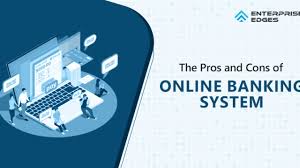Have you ever stopped to think about how online banks safeguard your money against the ever-present threats of cybercrime? In our fast-paced, technology-driven world, the face of bank robbery has dramatically changed. Gone are the days when masked thieves would break into physical locations; today’s criminals lurk behind computer screens, employing sophisticated tactics to steal funds.
To protect your hard-earned savings, online banks rely on advanced encryption methods that scramble your data, making it virtually impossible for unauthorised users to access sensitive information. Firewalls act as barriers, filtering out malicious traffic and thwarting intrusion attempts.

Moreover, multi-factor authentication adds to it by requiring multiple forms of verification before granting access. This means that even if a hacker obtains your password, they will likely be blocked by other protective measures.
Banks also continually monitor accounts for unusual activity, quickly flagging anything suspicious and alerting account holders immediately. Regular security updates and employee training ensure that staff members remain vigilant and prepared against evolving threats.
In this digital age, while risks may exist, reputable online banks prioritise cutting-edge defences to keep your finances secure. So next time you log in to manage your money online, rest assured that layers of protection are standing between you and potential dangers lurking in cyberspace.
Online banks implement various security measures to protect their customers’ financial information. While practices may vary from one institution to another, many foundational strategies remain consistent across the industry. For instance, companies like MoneyLion employ numerous software solutions to bolster their defences against cyber threats.

One critical layer of protection is the use of sophisticated anti-virus and anti-malware programs. These tools, such as Intel’s (NASDAQ: INTC) McAfee, are essential for guarding against harmful software that could infiltrate the bank’s systems.
These protective programs undergo constant updates to ensure maximum effectiveness. The tech landscape evolves rapidly, with new viruses and malware emerging regularly; thus, staying ahead requires vigilant monitoring and timely adaptations in security measures.
In addition to real-time scanning for threats, online banks often incorporate encryption protocols to safeguard sensitive data during transmission. This ensures that information exchanged between customers and the bank remains secure from prying eyes.
Overall, while each bank may tailor its security practices differently, the commitment to protecting customer data remains paramount across all online banking platforms.

Firewalls are a crucial component of modern online security. They act as protective barriers, intercepting potentially harmful data from suspicious websites before it can enter a user’s system. This initial line of defence scans incoming traffic for threats, ensuring that only safe and verified data is allowed through.
Many individuals remain cautious about online banking due to concerns that their devices, whether smartphones or tablets, could be hacked. This apprehension is understandable, given the rising sophistication of cybercriminals. In response, online banks continuously develop advanced security measures to enhance account protection.
One effective strategy they employ is multi-factor authentication (MFA). This method requires users to provide multiple forms of verification before granting access to their accounts. By combining something a user knows—like a password—with something they have, such as a smartphone app that generates temporary codes, MFA significantly reduces the likelihood of unauthorised access.

As hackers become more resourceful, these layered security protocols not only bolster user confidence but also create formidable obstacles for would-be intruders. Through persistent innovation in online security practices, banks strive to protect their customers’ sensitive information while fostering trust in digital banking services.
In today’s digital age, securing your banking information has never been more critical. Financial institutions offer a range of advanced security features to protect your accounts. These include thumbprint verification and facial recognition, which provide quick and reliable access. You might also enter passwords or PINs multiple times for added security or receive verification codes sent directly to your email.

Some banks take it a step further with biometric authentication methods like eye print verification and voice recognition. These technologies serve as robust shields against online hackers, effectively safeguarding your sensitive data without the hefty fees associated with traditional brick-and-mortar banks.
Additionally, most banks automatically log you out of your account after a short period of inactivity. This feature ensures that no one can access your account if your device is lost or stolen. Cookies play an essential role, too. They are small pieces of text stored by your web browser that help identify your computer during future logins, streamlining the authentication process while maintaining high-security standards. All these layers work cohesively to keep your banking experience safe and efficient.

Maxthon
In today’s digital age, where our interactions increasingly unfold online, safeguarding your banking details has become more vital than ever—mainly when using a browser such as Maxthon. There are several proactive measures you can undertake to enhance the security of your financial data and maintain its confidentiality.
To begin with, establishing solid passwords for your online banking accounts is paramount. These passwords should be both unique and complex, incorporating a mix of uppercase letters, lowercase letters, numbers, and special symbols to create combinations that are difficult to decipher. It’s essential to steer clear of using easily accessible personal information like birthdays or names of pets; instead, aim for intricate combinations that would pose a challenge even for the most relentless cybercriminals.

Another critical step in fortifying your security is activating Two-Factor Authentication (2FA), provided your banking institution offers this feature. Enabling 2FA adds an extra layer of protection to your account since it requires you to enter a verification code sent via text message or email every time you log in. This additional requirement acts as an effective deterrent against unauthorised access attempts.
Equally important is keeping your Maxthon browser up-to-date. Regularly checking for updates ensures that you’re utilising the latest version of the software, which frequently includes crucial security patches designed to address recently identified vulnerabilities.
Moreover, it’s advisable to develop a habit of routinely clearing your browsing data. This practice involves deleting your browsing history and removing cache files and cookies on a regular basis. By doing so, you minimise the risk of leaving behind sensitive information that could be exploited by hackers who might gain access to your device.
For individuals who value privacy highly while conducting their online banking transactions, taking advantage of Maxthon’s privacy mode can be incredibly beneficial. This feature enables users to navigate the web without retaining any records of their activities, providing an additional layer of confidentiality during their financial dealings online.
